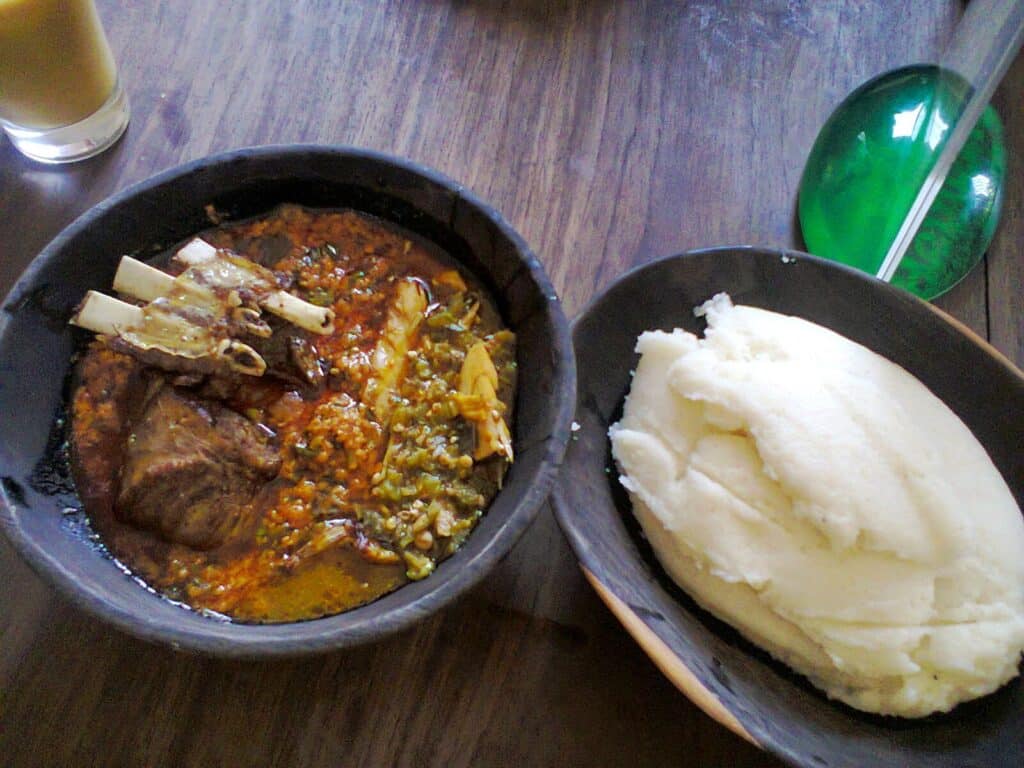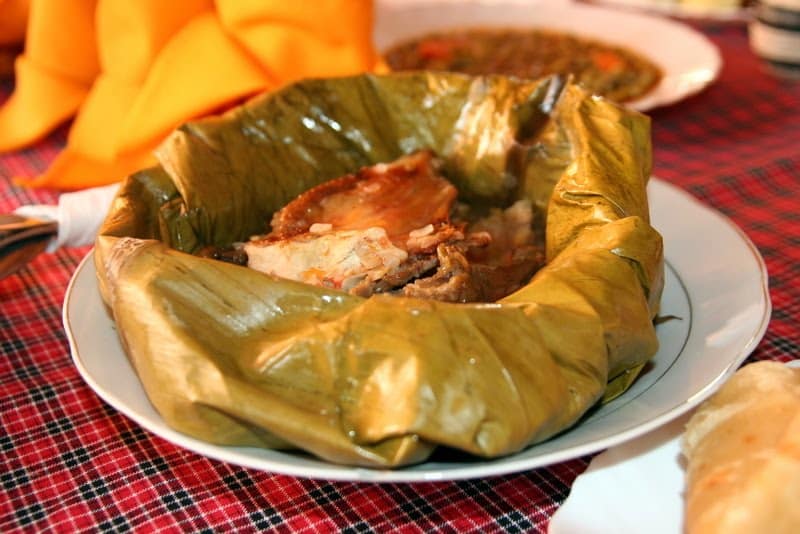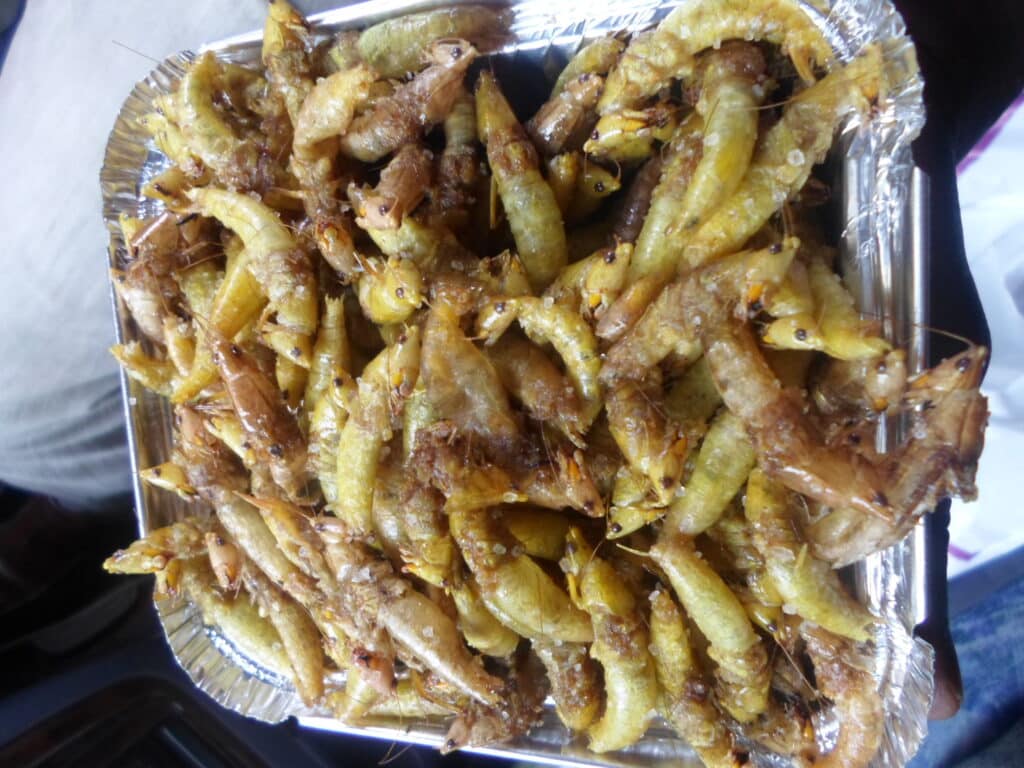Green fields, abundant wildlife, and stunning waterfalls define Uganda’s distinctive landscape. The only landlocked country in East Africa, its culture is a mixed heritage from dozens of ethnic groups and its neighbors like Kenya, Tanzania, Congo, and South Sudan.
Agriculture is widely practiced, and most people still grow their own food. As a result, Ugandan cuisine is very healthy and fresh. It features dishes based on common staple foods and unique ingredients that make eating out an exciting adventure.
As part of our National Dishes series, here’s the Remitly guide to Ugandan food to help you explore this diverse food landscape.
Memorable traditional dishes and street foods from Uganda
Ugandan food is an unforgettable taste journey through various regions, influences, and flavor profiles. Here are 10 of the most quintessential dishes to get you started:
Matoke

Ugandan matoke, or matooke, is one of the country’s most famous traditional dishes. The stewed green banana mash incorporates chicken stew, vegetables, and chilies, a tasty mixture that’s then steamed in—and served on—fresh banana leaves. Spices like ginger, garlic, curry, and coriander add a distinct taste.
Some variations replace green bananas with unripe plantain and chicken with different meats, especially beef. Try it for yourself with this traditional matoke recipe.
Matoke comes from the Luganda word “màtooke,” which means “banana” or “plantain.” It refers to the special type of green banana cultivar found throughout the East African highlands.
Katogo
Katogo is an important local food from Buganda and Western Uganda. It is a typical breakfast meal often paired with tea, mandazi (a fried bread-like pastry), or avocado slices. For the classic recipe, all you need is boiled cassava and red bean stew.
However, another version—matoke katogo—is made by mixing matoke (green bananas) with a tripe (offal) sauce. Ugandans call this popular variation of the dish katogo-byenda. But if tripe isn’t to your taste, you can use beef or ghee instead.
Posho

Posho is an African phenomenon. It’s known by many names, from ugali in Kenya to nshima in Zambia, kenkey in Ghana, and more. But it all refers to a cornmeal dish that requires only boiling water and maize flour (or corn flour) to make.
Despite its simplicity, this Ugandan staple food is quite versatile. Prepare posho and serve it hot or cold with side dishes containing meats, fish, or vegetables.
Binyebwa
Nothing beats the taste of binyebwa, Uganda’s famous groundnut sauce. As the name suggests, traditional g-nut sauce is made almost entirely from roasted groundnuts (or peanuts), with tomatoes, onions, and a pinch of spices to taste.
Peanut sauce served with matoke is one of the most popular meals here. For most tourists and expats, it’s the distinctive taste of Uganda. However, binyebwa also goes with side dishes like rice, posho, matoke, cassava, or dried fish.
Luwombo

Originally reserved for kings, today luwombo or oluwombo is a standard part of Ugandan cuisine. This delicacy comes from Buganda, the land of the Kabaka, where the term “luwombo” means “to cook in leaves.”
Luwombo is a rich meat and mushroom stew cooked slowly in banana leaves on low heat. Most Ugandans use chicken for this recipe, but beef or pork works just as well. Chicken luwombo always makes an appearance at special occasions, and it can only be prepared by specific people depending on the event. Tip: try adding some peanut sauce to enhance the meat flavors of this delicious dish.
Kikomando
As crowd favorites go, it’s difficult to find a more beloved traditional food in East Africa than chapati. This unleavened flatbread goes well with everything and you can have it at any time, so it’s central to many Ugandan meals.
Kikomando is a Ugandan delicacy that’s a mix of chapati and beans. To start, prepare chapati and cut it into small pieces. Then, combine the chapati pieces with your kidney bean stew to create a hearty, flavor-packed meal.
Rolex

Rolex is one of those unique dishes that could only have been born in Uganda. The popular street food is based on the humble chapati, and it consists of a vegetable omelette rolled up in one or two chapatis.
A Ugandan rolex is only as simple or elaborate as your tastes. Vendors typically add tomatoes, diced onions, bell peppers, shredded cabbage, or other fresh ingredients to elevate the recipe.
Muchomo

Another common Ugandan street food, muchomo refers to cubed pieces of meat roasted over an open wood or charcoal flame. These meat skewers are similar to standard kebabs but utilize different ingredients and preparation techniques.
Muchomo recipes typically call for beef. However, you can use pork, goat meat, or even chicken.
Nsenene

Nsenene is one of Uganda’s most unique local foods. It comes from the country’s central region and its name means “grasshopper.” As you might have guessed, nsenene are fried grasshoppers commonly prepared in street food stalls or by curious children at home.
This popcorn-like snack only requires two ingredients: long-horned green grasshoppers, abundant in the East African bushlands, and salt. But you can personalize the recipe by adding grated carrots, bell peppers, ground black pepper, or other spices.
Simsim
Simsim, also known as alawa, is a sweet treat the whole family can enjoy. “Simsim” means “sesame seeds” and it comes from the Acholi and Langi people in Uganda’s dry lands. Sesame seeds are high in protein and healthy fats, giving this dessert nutritional value as well as a unique flavor.
This recipe is a great place to start if you want to try this tasty treat. Make it by frying simsim until golden brown and coating the seeds in caramelized sugar. You can form the resulting mixture into bars or small balls.
More Ugandan dishes you should try
Apart from the traditional dishes on our list, consider adding several other Ugandan foods to your itinerary:
- Samosa, a savory pastry typically stuffed with cooked minced meat, Irish potatoes, or green mung beans.
- Nswaa is another insect-based delicacy, this time made by frying white ants (termites).
- Karo, which means “millet”, is a type of millet bread that’s usually served with eshabwe, a local ghee sauce.
- Mandazi is a sweet pastry often paired with tea, groundnuts, sweet potatoes, or yams for a filling breakfast.
- Muwogo, which refers to a fried cassava snack.
The story of Uganda’s food
Ugandan food stands out for its unique mix of flavors with origins in Indian, Arab, and indigenous cultures. Commonly used ingredients include staple foods such as:
- Green bananas
- Plantain
- Cassava
- Millet
- Yam
These make the base for most meals, which locals pair with elements like fish, nuts, fruits, and different types of meats.
Exploring Ugandan cuisine in the U.S.
Ugandan nationals are tightly bound to their ancestral land, so the decision to work or study abroad is always difficult. But when they do move to the U.S., they mainly join significant Ugandan migrant communities in California, Texas, Massachusetts, Maryland, and Illinois. These states offer some of the best Ugandan cuisine for foodies with a taste for authenticity.
Discover more about Uganda
Uganda’s official languages are English and Swahili, and they’re widely spoken in its capital, Kampala. With a population of over 1.8 million people, it’s the country’s largest city and home to Lubiri Palace, the former seat of the Kabaka (king) of Buganda.
Most people in Uganda send and receive money through mobile transfers, and network providers like Airtel and MTN lead the charge. Online services like Remitly are a fast, reliable option.
How Does Ugandan Food Reflect Cultural Influences Similar to Peruvian Cuisine?
Ugandan food, influenced by diverse cultures, mirrors the colorful tapestry found in Peruvian cuisine. Both culinary traditions incorporate local ingredients and traditional cooking techniques, creating vibrant dishes. As you explore the rich flavors of peruvian cuisine, you’ll find similarities in the communal nature of meals and the use of fresh produce in both regions.
FAQs
What does Ugandan food taste like?
The taste of traditional Ugandan food is challenging to describe because it draws inspiration from numerous regions and cultures. However, it’s defined by staple foods like green bananas, cassava (yucca), and groundnuts (peanuts), as well as fresh ingredients from the home farm.
What is the most popular food in Uganda?
Uganda is a country with diverse peoples and delicacies, so pinpointing the most popular food is next to impossible. However, most Ugandans celebrate matoke, which is the closest thing to a national dish.
What are some common ingredients used in Ugandan cuisine?
Ugandan cuisine prioritizes freshness, so most traditional dishes use fresh vegetables and staple foods like green bananas, plantains, cassava flour, groundnuts, and yams. Authentic recipes also include spices such as black pepper, cumin, coriander, and more.

